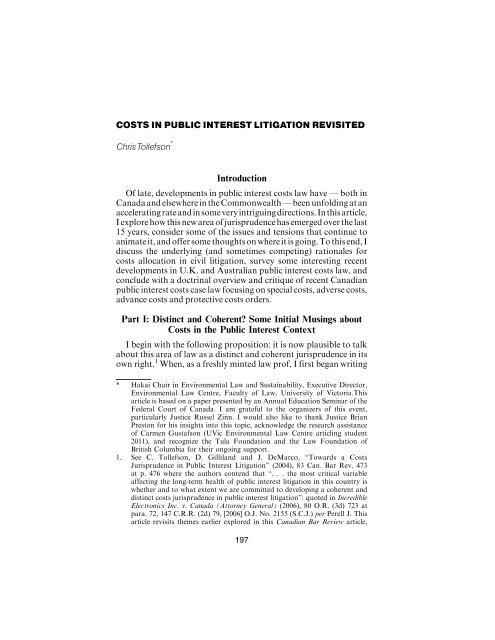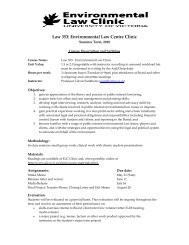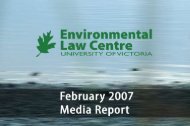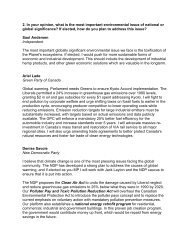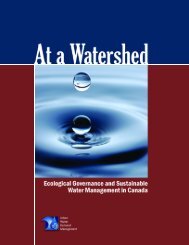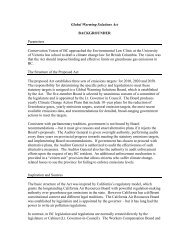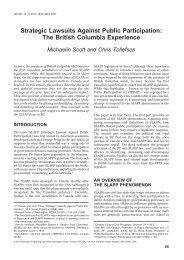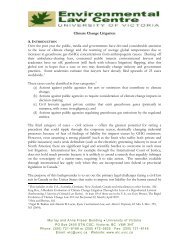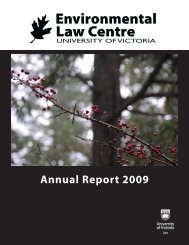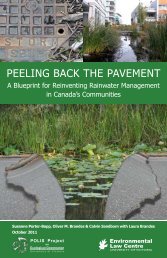COSTS IN PUBLIC INTEREST LITIGATION REVISITED ...
COSTS IN PUBLIC INTEREST LITIGATION REVISITED ...
COSTS IN PUBLIC INTEREST LITIGATION REVISITED ...
You also want an ePaper? Increase the reach of your titles
YUMPU automatically turns print PDFs into web optimized ePapers that Google loves.
2011] Costs in Public Interest Litigation 201In Australia the trajectory with respect to legal developments inthis area of costs law has been somewhat similar. There, withoutquestion, the most influential landmark is the 1995 Report of theAustralianLaw Reform Commission(ALRC) entitled Costs Shifting— Who pays for litigation? 16 This broadly mandated inquiry intocosts rules explored whether and to what extent existing costs rulespromoted access to justice and due process across the entireAustralian legal system. Four of its 65 recommendationsspecifically addressed costs in public interest cases. It advocated, inthissetting,legislativerecognitionofajudicialpowertomake“publicinterest costs orders” (at any stage of the proceedings) to relieve aparty of paying some or all of an adverse party’s costs(Recommendation 47). It also suggested indicia for identifyingpublic interest cases, urging that the mere existence of a personalinterest in the matter on the part of one or more of the parties shouldnot necessarily affect this characterization (Recommendation 45)and recommending that courts recognize and exercise the power to“cap” costs in advance (Recommendation 39).Both judicially and by statutory amendment, these public interestrelatedrecommendations have gained considerable attention andsome measure of traction. Courts in New South Wales, particularlyits Land and Environment Court, have played a leading role in thedevelopment of an emerging public interest costs jurisprudence. 17 Atthe federal level, and in other states, courts have shown a greaterreluctance to depart from the English Rule in public interest cases. 18There is also a growing body of case law on protective costs ordersand “cost-capping” in civil rights litigation arising out of theinterpretation of newly enacted federal and state cost-cappingprovisions: see Haraskin v. Murrays Australia Ltd. 19Without a doubt, however, it is in the United Kingdom where costslaw reform has gained the greatest momentum. There developments16. ALRC Report 75 (1995), online: 5http://www.alrc.gov.au/report-754.17. See Oshlack v. Richmond River Council (1998), 193 CLR 72, [1998] HCA 11,152 ALR 83; Blue Mountains Conservation Society v. Delta Electricity, [2009]NSWLEC 150, 170 LGERA 1, affd [2010] NSWCA 263, 176 LGERA 424and Caroona Coal Action Group Inc. v. Coal Mines Australia Pty Ltd (No 3),[2010] NSWLEC 59, 173 LGERA 280.18. For a very useful current overview of the Australian context see PublicInterest Law Clearing House, “Protective Costs Orders in Public InterestLitigation: Jurisprudence Review 2011” (PILCH: Melbourne, 2011). Furtherlegislative reforms in this area may be on the horizon: see New South WalesLaw Reform Commission, Security for costs and associated costs orders(Consultation paper 13: May 2011).19. [2010] FCA 1133.
202 The Advocates’ Quarterly [Vol. 39have unfolded on two fronts. A major growth area in the case lawsince the late 1990s has been the emergence of protective costs orders,or “PCOs”. Protective costs orders are now regularly sought bypublic interest litigants at or near the commencement of litigation.They are intended to enhance access to justice by providing suchlitigants with some degree of immunization against adverse costsliability. This typically occurs by means of an order that “caps” at apredetermined amount what a litigant will recover (if successful) orfor which they will be liable (if not). The leading case on PCOs is a2005 Court of Appeal decision known as Corner House Research. 20AswillbediscussedinPartIII,the CornerHousetesthasbeenbroadlycriticized for not going far enough to promote access to justice. And,indeed, the English Court of Appeal in two recent cases hasacknowledged that the Corner House approach must be liberalized,at least in environmental assessment litigation, to comply with theU.K.’saccesstojusticeobligationsundertheAarhusConventionandassociated EU directives. 21Even more intriguing is the potential that the U.K. will soonlegislatively jettison its ancient two-way English costs rule in favourof a one-way model. 22 This possibility presents itself as a result of acluster of factors that have led both politicians and the profession toconclude that dramatic action must be taken to bring spiralinglitigation costs under control. 23 In the U.K., even more so than inCanada, the “loser pays” approach to costs ensures that litigation is20. R (Corner House Research) v. Secretary of State for Trade and Industry,[2005] 1 WLR 2600, EWCA Civ 192, [2005] 4 All E.R. 1, cited infra as CornerHouse.21. See Morgan v. Hinton Organics (Wessex) Ltd., [2009] EWCA Civ 107, [2009]2 P & CR 4, [2009] Env LR 30 and R (on the application of Garner) v.Elmbridge BC, [2010] EWCA Civ 1006, [2011] 1 Costs LR 48, [2010] 3 EGLR137. See also further discussion infra, text accompanying footnotes 46-48.22. Controversy in the U.K. over access to justice has been a significant politicalissue since the early 1990s. In 1996 Lord Woolf concluded a two-year reviewof the country’s civil law system by remitting a report titled Access to Justice(available at 5http://webarchive.nationalarchives.gov.uk/+/http://www.dca.gov.uk/civil/final/index.htm4). This led to the most significantreforms of civil law in a century including new civil court rules and theAccess to Justice Act 1999 (UK), c. 22. See J. Eaglesham and J. Mason,“Civil justice: the Woolf reforms: legal system poised for ‘big bang’ overhaulfrom today”, Financial Times (April 26, 1999), p. 10. However, costs rulesremained largely unaffected and, as such, increasingly were identified as akey access to justice issue setting the stage for Jackson L.J.’s appointment.See generally M. Peel and M. Murphy, “Judge set to probe costs oflawsuits”, Financial Times (November 3, 2008), p. 7 and “Access to Justice —Justice Restructured” The Post Magazine (February 5, 2009), p. 15.23. Peel and Murphy, ibid.
2011] Costs in Public Interest Litigation 203inevitably a high stakes game — a function of the fact that there, thelosing party is typically liable to indemnify the winner for its full legalcosts (unlikein Canada where the indemnification in ordinarycases istypically less than 50%).The most recent and forceful volley in this growing debate is aprovocativeand far-reachingreporton thecostslawreformauthoredby Lord Justice Jackson and released in early 2010. 24 Among hisrecommendations is instituting a general one-way rule for all judicialreview petitions against government action. More controversially,however,he urgeseliminatingthe abilityof plaintiffsto insure againstadverse costs awards (by means of ATE or “after the event” policies).Currently, if a claim succeeds, the costs of the ATE are passed ontothe other side as a recoverable disbursement.Part II: Towards a Principled Approach to CostsAllocation in Public Interest LitigationIn the preceding part, I argued that recent legal developments inCanada, Australia and the U.K. have strongly trended towards agreaterappreciationandpracticalrecognition of theuniquenature ofpublic interest litigation and the importance of the judicial role inensuring its continued viability. In this part, I consider how thesedevelopments relate to the rationales underpinning costs allocation,and whether and to what extent a more principled and predictablepublic interest costs jurisprudence is emerging.(1) Rationales for Costs AllocationIt is worthwhile to start out by rehearsing the rationale for thetraditional English rule that costs follow the event. In manyjurisdictions, particularly those where costs law remainsuncodified, this rationale is seldom articulated, let alonequestioned. Historically, the predominant reason for the “loserpays” rule was a compensatory rationale. 25 It comes in two mainguises. The first is based on the notion of fault: that the successfulparty should be compensated for some or all of its litigation costs onthe footing that the unsuccessfulparty shouldbe deemed to have beenat fault (either in its conduct of the litigation, or the underlying24. Lord Justice Jackson, Review of Civil Litigation Costs: Final Report (2010),online: 5http://www.judiciary.gov.uk/NR/rdonlyres/8EB9F3F3-9C4A-4139-8A93-56F09672EB6A/0/jacksonfinalreport140110.pdf4 (hereafter theJackson Report). The report was commissioned about 18 months earlier bythe office of the Master of the Rolls.25. Tollefson, supra, footnote 7, at pp. 309-11.
204 The Advocates’ Quarterly [Vol. 39transaction,orboth)andthattheprevailingpartyisthereforeentitledto be made whole. In this variant, costs are seen as being akinremedially to damages. A second variant of the compensationrationale, typically invoked where a fault-based analysis wastenuous, is the spoils-based rationale. Under this approach, costspresumptively flow to the winner as a form of just desert. Here theoverarching concern is fairness to the winner; other factors, relatingto the nature of the case or the circumstances of the unsuccessfulparty, are deemed irrelevant.Allied against the loser pays presumption embedded in the EnglishRule are two competing considerations: what might be termed thepublic benefit and the access to justice rationales. While these tworationales are closely related and sometimes conflated, they aredistinguishable. While the public benefit rationale mandates autilitarian evaluation of the litigation from the public’s perspective(and the related desirability of promoting the adjudication of similarcases and issues), the access to justice rationale is concerned withensuring that costs rules do not impede weaker or more poorlyfinanced interests from pursuing claims against more powerfuladversaries. 26Where the court concludes that there is misconduct by a party tothe litigation, yet another rationale for allocating costs becomesrelevant. In jurisdictions where the English Rule holds sway thepunishment rationale is triggered in one of two situations: where thewinning party has engaged in misconduct or sharp practice such thatthe punishment rationale would justify a denial of costs, or where thelosingpartyhasengagedinmisconductorsharppracticesuchthatthewinning party should be entitled to an elevated level of costs. 27Over the last 15 years, Canadian courts have become increasinglycomfortable with the notion that litigation involving the publicinterest raises unique policy considerations that may justify adeparture from ordinary costs rules. 28 In so doing, they haverecognized that the view that the compensatory rationale forawarding costs (described above) is only one of several factors to beconsidered when crafting costs orders: see Okanagan Indian Band. 29Indeed, in, a majority of the Supreme Court made it clear that courts26. Ibid., at p. 313.27. Ibid., at p. 311.28. To paraphrase the B.C. Court of Appeal in Victoria (City) v. Adams, 2009BCCA 563 at para. 181, 313 D.L.R. (4th) 29, [2010] 3 W.W.R. 1, where thecourt cites the S.C.C.’s decision Okanagan Indian Band, supra, footnote 10,and its own decision in Barclay (Gurdian ad Litem of) v. British Columbia,2006 BCCA 434, 381 W.A.C. 98, 57 B.C.L.R. (4th) 63.29. Supra, footnote 10, at para. 24.
2011] Costs in Public Interest Litigation 205should regard their power to award costs as a legitimate “instrumentof policy” to be deployed in a manner that “helps to ensure thatordinary citizens have access to the justice system when they seek toresolve matters of consequence to the community as a whole”. 30In some jurisdictions the relevance of access to justice and publicbenefit rationales in costs determinations has been reinforced bystatutory language. For instance, since 1998 Federal Court Rule 400has affirmed a “full discretionary power over the amount andallocation and the determination of by whom they are to be paid”:Rule 400(1). 31 Among the factors courts may consider in exercisingthis discretion are “whether the public interest in having theproceeding litigated justifies a particular award of costs”: Rule400(3)(h).(2) Coherence and Predictability in Allocation Costs in PublicInterest Cases. . . because costs are a matter of judicial discretion, it is to be expectedthat the case law about costs will not demonstrate a consistent pattern;nevertheless a review of the case law does reveal erratic andunpredictable results in cases of public interest litigation . . . 32Now that the legitimacy of allocating costs mindful of publicinterest considerations (including the public benefit and access tojustice rationales) is broadly accepted, arguably the next challenge isto enhance the coherence and predictability with which suchdecisions are made. It is difficult to quarrel with Perell J.’sassessment of the state of the case law set out above, particularlythat of earlier vintage. But just how much more coherence andpredictability can be achieved is debatable.One view is that whenever the matter involves a public interestlitigant or constitutes public interest litigation, courts shouldpresumptively be prepared to craft some form of “special” publicinterest costs order. 33 It would be wrong, of course, to assume thatthis “binary” test would necessarily lead to more generous treatmentofpublicinterestlitigants.Thatwoulddependontherigourofthetestto establish that a case (or a litigant) qualified for special treatment.Moreover, the form of order may itself, in the end, not differ30. Ibid., per Lebel J., at para. 27.31. The effect and implications of the 1998 amendments are discussed inTollefson et al., supra, footnote 1, at pp. 489-90.32. Perell J. in Incredible Electronics Inc. v. Canada (Attorney General), supra,footnote 1, at para 74.33. See the decision of Perell J. in Incredible Electronics, ibid.
206 The Advocates’ Quarterly [Vol. 39significantly in its terms from what would have been ordered in theprivate interest setting. Nonetheless, there are those who would resistevengoingthisfar.Traditionalistsarguethatitisdangeroustoseektodraw a bright line distinction between private and public interestlitigation in relation to costs — that it is critical in this area to preservea broad judicial discretion that takes account of the specific featuresof particular cases and does not distinguish between public andprivate interest litigation. 34Increasingly, it would seem, courts are coming down somewherebetween these two positions. As discussed in Part III, before theymake what might be termed generically a “public interest costsorder”, courts are looking to the applicant to demonstrate not onlythat they are a public interest litigant but also that there are othercircumstances or features of the litigation that militate in favour ofthe order sought. How this judicial expectation (that there be“something more” to a case in order to justify special costs treatment)should be articulated and applied remains a matter of some debate. 35As a preliminary caveat to a consideration of the case law, it isworthbearinginmindthatthejurisprudenceshouldbereadinlightofsignificant differences that can exist as between jurisdictionsdepending on whether and how the law of costs has been codified.This caution is of particular relevance in our Federal Courts. There,prior to the 1998, the default position as to costs was a no way regime.In 1998, this default preference was replaced as a result ofamendments that affirmed, instead, a broad discretionary power toaward costs based on a menu of factors. Included on this menu is onethat specifically empowers a court to consider the public interestnature of the proceeding. 36 Accordingly, to secure a costs order in34. This theme is strongly articulated in the majority judgment of Bastaracheand Lebel JJ. in Little Sisters, supra, footnote 11: see, for example, paras. 5,35 and 64. Indeed, some courts have mused that recognition of a distinctpublic interest costs jurisprudence could give rise to more erratic andunpredictable results (rather than less). To a similar effect is the followingpassage from a judgment of the Court of Appeal for Western Australia:“great care must be taken with the concept of public interest litigation that itdoes not become an umbrella for the exercise of discretion with respect tocosts in an unprincipled, haphazard or unjudicial manner”: Buddhist Societyof Western Australia (Inc) v. Shire of Serpentine-Jarrahdale, [1999] WASCA55 at para. 11, cited in Caroona Coal Action Group Inc v. Coal MinesAustralia Pty Ltd (No 3), [2010] NSWLEC 59 at para. 12.35. The existence of “special circumstances” has now become a requirement foran advance costs order under Okanagan, supra, footnote 10. In Australia, asimilar requirement (referred to as the “something more” test), has beenproposed in considering public interest costs applications: see Caroona, ibid.For further discussion see Part III.
2011] Costs in Public Interest Litigation 207Federal Court based on a public interest rationale an applicant doesnot need to persuade the court to depart from the “ordinary” order.This would seem to suggest that that such orders should be morereadily available in Federal Court than in jurisdictions that maintaina statutory or common law English Rule as to costs.Part III: A Consideration of the Public InterestCosts Case LawIn this part, I propose to discuss the main forms of “public interestcosts orders” that have been made in Canadian courts. The focus herewill be on the high-level issues and trends that appear to be emergingfrom the leading cases. By no means should what follows be regardedas a comprehensive statement of what is a large and rapidlyexpanding case law.To date, the Canadian costs case law in the context of publicinterest litigation has dealt with three main scenarios: 37. ex post applications for special costs;. ex post applications for relief/immunization from adversecosts liability; and. ex ante applications advance/interim costs.A fourth form of public interest costs order, which has in recentyears come to play an important role in Australian and especiallyU.K. jurisprudence, is the protective costs order (PCO). Like theadvance costs order, the PCO is by definition an ex ante order. Todate, there is only one reported Canadian decision involving anapplication for a PCO. 38 In the remainder of this part, I will considerthe case law on special costs and costs immunity, then turn to theadvance costs case law, and conclude with a discussion of the PCOjurisprudence.(1) Ex Post Claims for Special Costs and Relief from AdverseCosts LiabilityIn relation to applications by public interest litigants for specialcosts and relief from adverse costs, Canadian courts are increasinglyapplying a set of principles derived from what has proven to be a36. See Rule 400.37. As recognized and catalogued by the B.C.C.A. in Victoria (City) v. Adams,supra, footnote 28, at para. 182.38. Farlow v. Hospital for Sick Children, [2009] O.J. No. 4847, 100 O.R. (3d) 213,83 C.P.C. (6th) 290 (S.C.J.).
208 The Advocates’ Quarterly [Vol. 39highly influential report authored by the Ontario Law ReformCommission (OLRC). 39In its 1989 Report on the Law of Standing, the OLRC bluntlyobserved that “costs rules . . . pose a formidable deterrent to litigationof the kind that our proposals [on standing] are intended to facilitate,and thus may fatally undermine our recommendations for the law ofstanding”. 40 The report went on to set out a series of five criteria fordetermining whether a special public interest costs award iswarranted: 41. The proceeding involves issues the importance of which extendsbeyond the immediate interests of the parties involved.. The person has no personal, proprietary or pecuniary interest inthe outcome of the proceeding, or, if he or she has an interest, itclearly does not justify the proceeding economically.. The issues have not been previously determined by a court in aproceeding against the same defendant.. The defendant has a clearly superior capacity to bear the costs ofthe proceeding.. The plaintiff has not engaged in vexatious, frivolous or abusiveconduct.These five factors have been approved by various trial andappellate courts including the B.C. Court of Appeal and the FederalCourt. 42The most sustained judicial consideration of the OLRC test isVictoria (City) v. Adams. 43 In this case, the court noted that several39. Ontario Law Reform Commission, Report on the Law of Standing (Toronto:Ministry of the Attorney General, 1989).40. Ibid., at p. 137.41. Ibid., at p. 179.42. See Guide Outfitters Assn. of British Columbia v. British Columbia(Information and Privacy Commissioner), 2005 BCCA 368, 353 W.A.C.158 sub nom. British Columbia (Minister of Water, Land and Air Protection)v. Information and Privacy Commissioner (B.C.), 30 Admin. L.R. (4th) 166;Victoria (City) v. Adams, supra, footnote 28; Harris v. Canada, 2001 FCT1408, [2002] 2 F.C. 484, [2002] 1 C.T.C. 243 and Georgia Strait Alliance v.Minister of Fisheries and Oceans, [2011] F.C.J. No. 587, 59 C.E.L.R. (3d)103, 2011 CarswellNat 1510 (F.C.) (April 26, 2011 per Russell J.). See alsoVancouver (City) v. Zhang, [2011] B.C.J. No. 469, 2011 BCCA 138 andAhousaht Indian Band v. Canada (Attorney General), [2011] B.C.J. No. 2032,2011 BCCA 425.43. Supra, footnote 28. The approach set out in this case has since been appliedby the court in other cases most notably Morton v. British Columbia(Minister of Agriculture and Lands), [2010] B.C.J .No. 2373, 2010 BCCA435, [2011] 3 W.W.R. 677, where the court upheld an award of special costsmade by the trial judge in a successful constitutional test case challengingprovincial jurisdiction over marine-based salmon aquaculture operations.
2011] Costs in Public Interest Litigation 209years previously in its Guide Outfitters Association decision, it hadapproveduse of the OLRCtest to determine whether a partyclaimingto be a public interest litigant should be excused from adverse costsliability. In the present case, it dealt with the oppositesituation, one inwhich a successful public interest litigant was seeking an order forspecial costs.Despite this difference, however, the court concluded that inprinciple the two cases were not all that dissimilar. Both in GuideOutfitters and this case, the court was being asked to derogate fromthe normal rule as to costs. However, “not all forms of departure”from the normal rule “are of equal magnitude”. 44 Conceived as aspectrum of potential costs awards, an award of advance (or interimcosts) or an award of costs to an unsuccessful party are significantlymore exceptional orders and would thus require the claimant tomount a more compelling justification. Here, the court concluded, alesser form of justification might well suffice.In the result, therefore, the B.C.C.A. in Victoria (City) v. Adamsconcluded that a similar (or even identical), slightly modified test canbe applied in all cases where the court is being asked to depart “fromthe normal rule” as to costs. 45 The extent of the justification, in itsview, will depend on the “magnitude of derogation from the usualcost structure of the award being considered”. 46 Its modified anddistilled version of the OLRC test has four elements. 47. the case involves matters of public importance that transcend theimmediate interests of the named parties, and which have not beenpreviously resolved;. the [claimant] has no personal, proprietary or pecuniaryinterest in the outcome of the litigation that would justify theproceeding economically;. [the party opposing the claimant] has a superior capacity tobear the costs of the proceeding; and. the [claimant] has not conducted the litigation in an abusive,vexatious or frivolous manner. 48It would appear based on the case law that a claimant in a publicinterest case seeking to either recover special costs or be relieved ofadverse costs liability must satisfy all four elements of this “bundled”test. And, of course, a claimant’s prospects for success will be44. Victoria, ibid., at para. 190.45. Ibid.46. Ibid.47. For convenience, I have inserted the word “claimant” to denote the publicinterest party that is invoking the claim for public interest costs treatment.48. Victoria (City) v. Adams, supra, footnote 28, at para. 188.
210 The Advocates’ Quarterly [Vol. 39significantly enhancedif,inadditiontosatisfyingtheabovetest,thereare other factors in the litigation that tend to favour the order they areseeking.A good illustration of this is a recent judgment of Russell J. inGeorgia Strait Alliance v. Minister of Fisheries and Oceans (alsoknown as the Consolidated Orcas). 49 In this case, a complicated pieceof litigation under the Species at Risk Act 50 involving two petitionsthat were ultimately heard together, the applicant prevailed on themerits and later sought its solicitor-and-client costs. Applying theOLRC test, as approved by the Federal Court in Harris v. Canada,Russell J. concluded that public interest considerations militated infavour of the order sought. 51 In addition, however, he concluded thatsuch an order was justified as the result of the “unjustifiably evasiveand obstructive approach” undertaken by the respondents that“unnecessarily lengthened and complicated the proceedings”. 52What I have termed the “bundled” approach to assessing ex postcosts claims made by public interest litigants (inspired by the OLRC,applied in the Harris, Georgia Strait Alliance and Guide Outfittersdecisions, and most recently distilled by the B.C.C.A. in Victoria(City) v. Adams as discussed above) has much to commend it.Throughthis bundling,threekeyaspectsor rationalesfor exercisingajudicial discretion to make a costs order designed to take account ofthe special realities of public interest litigation are each givenexpression.The first element of thetest is a metric of the public benefitassociated with the case being litigated; the second and third elementsaddress access to justice considerations at play in the litigation; thefinal element recognizes the residual judicial discretion to considerother factors relating to the carriage of the litigation, including theapplicant’s own conduct.While B.C. and federal courts are supportive of this bundled49. See Georgia Strait Alliance v. Minister of Fisheries and Oceans, supra,footnote 42 (costs decision); and [2010] F.C.J. No. 1471, 2010 FC 1233, 379F.T.R. 183 (F.C.) (merits decision).50. S.C. 2002, c. 29.51. The Federal Court’s decision in Harris, supra, footnote 42, in adopting theOLRC approach, has found broad judicial approval: see, for example, R. v.Griffin, 2009 ABQB 696, [2009] A.J. No. 1445, [2010] 6 W.W.R. 657;Hastings Park Conservancy v. Vancouver (City), 2007 BCSC 147, 51 Admin.L.R. (4th) 165, 30 M.P.L.R. (4th) 60; Miller v. Boxall, 2007 SKQB 9, [2007] 3W.W.R. 119, 291 Sask. R. 113; Palmer v. Port Moody (City), 2006 BCSC1137, 28 M.P.L.R. (4th) 191, 151 A.C.W.S. (3d) 780; MacDonald v.University of British Columbia, 2004 BCSC 412, 26 B.C.L.R. (4th) 190, 45C.P.C. (5th) 251; Pauli v. ACE <strong>IN</strong>A Insurance Co., 2004 ABCA 253, 242D.L.R. (4th) 420, [2005] 1 W.W.R. 12.52. Georgia Strait, supra, footnote 49, at para. 14.
2011] Costs in Public Interest Litigation 211approach, in other jurisdictions somewhat different tests haveevolved. In Ontario, for example, in answering the question ofwhether a litigant should be relieved from adverse costs liability,courtshavetendedtodistilltheinquiryintoasinglequestion:namely,whether the applicant seeking relief is a “genuine” public interestlitigant. 53 According toPerellJ.,inhis detailedjudgmentin IncredibleElectronics, where a court concludes that this question should beanswered in the affirmative, the litigant in question should not besubject to the normal two-way costs regime.Perell J.’s single question approach entails asking initially whetherthe litigation raises issues that are important to the public at large: assuch, the threshold requirement of being a genuine public interestlitigant is, in his view, that they are “a partisan in a matter of publicimportance”. 54 The next stage of the analysis considers how and whythe litigation has been commenced. In this regard, Perell J. is criticalofthe “conventionalview”inthecaselawandliterature“thatapublicinterest litigant must, to some extent, manifest unselfish motives”. 55He contends that: 56altruism and having little to gain financially work better as indicia thancriteria for qualification as a public interest litigant . . . altruism may bea sufficient, but is not a necessary, criterion for qualification as a publicinterest litigant. Perhaps, other virtues such as courage, loyalty,patriotism, dedication to a worthy cause and the pursuit of justicemay qualify the litigant as a public interest litigant . . . sometimes arelevant but not determinative feature is that the public interest litigantis either the “other”, a marginalized, powerless or underprivilegedmember of society, or the public interest litigant speaks for thedisadvantaged in society, even if he or she has his or her own selfishreasons for litigating.Perell J. is also critical of the assumption that to merit relief fromthe ordinary two-way costs regime a public interest litigant mustestablish(asperthe OLRCtest)thatitisimpecuniousorthatthereisasignificant disparity between the parties in terms of economicresources. Here again, while he acknowledges that this feature ofthe litigation may militate in favour of the conclusion that theapplicant is a genuine public interest litigant, it should not beregarded as a “determinative measure”. In his words: 5753. See Incredible Electronics, supra, footnote 1, followed and applied inGreenspace Alliance of Canada’s Capital v. Ottawa (City), [2008] O.J. No.5152, 52 M.P.L.R. (4th) 155, 170 A.C.W.S. (3d) 646 (Div. Ct.).54. Incredible Electronics, supra, footnote 1, at para. 91.55. Ibid., at para. 95.56. Ibid., at paras. 98-99.
212 The Advocates’ Quarterly [Vol. 39A few public interest litigants may be affluent and prepared to use theirwealth to be a litigant in public interest litigation. A few public interestlitigants may be subsidized by government programs or lawyers willingto provide their services pro bono. It seems to me the point is not somuch whether the public interest litigant is affluent or impecunious butwhether having regard to the benefit of ensuring their participation, theyought to be immunized from an adverse costs consequence.PerellJ.’sobservationsprovideausefulreminderoftheneed,asthepublic interest cost jurisprudence evolves, for courts to avoidcategorical assumptions about the nature of public interestlitigation and more specifically the identity and motivations ofbeing treated for costs purposes as public interest litigants.Another judicial attempt to untangle and distill public interestcosts law has recently been offered by Justice Preston, Chief Judge ofthe New South Wales Land and Environment Court. 58 In CaroonaCoal Action Group Inc. v Coal Mines Australia Pty Limited andMinister for Natural Resources No 3, 59 he offered yet anothermethodology for, as he put it, “the principled exercise of costsdiscretion” in public interest cases 60 He argues that a careful reviewof the public interest costs case law reveals that courts “have used, ineffect, a three step approach in determining whether to depart fromthe usual costs rule” in such cases. He describes these three steps asfollows: 61. . . first, can the litigation be characterized as having been brought inthe public interest?; secondly, if so, is there “something more” than themere characterization of the litigation as being brought in the publicinterest?; and thirdly, are there any countervailing circumstances,including relating to the conduct of the applicant, which speak againstdeparture from the usual costs rule?The sequential approach advocated by Preston C.J., among otherthings, recognizes that not all cases raising public interest issues canor should be dealt with using distinct public interest costs principles.Sorting out the exceptional cases, in his view, can best be achieved in athree-stage process. In the first stage, the modest goal is to determine57. Ibid., at para. 100.58. The Land and Environment Court of New South Wales is a specialistsuperior court of record. Its jurisdiction includes merits review, judicialreview, civil enforcement, criminal prosecution, criminal appeals and civilclaims in planning, environmental, land and mining matters. It was createdby statute in 1979.59. Supra, footnote 17.60. Ibid., at para. 8.61. Ibid., at para. 13.
2011] Costs in Public Interest Litigation 213if the public interest is served by the litigation; whether, in otherwords,there arebenefitsflowingfromthecase thatextendbeyondtheinterests of the applicant. If the applicant surmounts this hurdle, theymust still persuade the court that there is “something more” to theircase that merits special costs treatment. This something more mayrelate to the nature of the case (i.e. the breadth or nature of publicbenefitsassociatedwithitsresolution)ortheidentityormotivationofits proponent (i.e. degree of altruism exhibited). Finally, if theapplicant succeeds on both of these grounds, the court must stillquery whether there are any countervailing factors (including theapplicant’s conduct or third party involvement or financingarrangements) that would militate against the order sought.Intriguingly, these three questions track — at least in a rough andready way — the four factors bundled into the OLRC test asreformulated by the B.C.C.A. in Victoria (City) v. Adams. 62 This isespecially true of the first and last elements of the OLRC test that arelargely congruent with the first and last steps of the test set out inCaroona. 63 Where Caroona departs from and potentially adds valueto the OLRC approach is in its pragmatic recognition that not all“public interest” cases will necessarily justify special costs treatment.While judicial elaboration of the OLRC test has for the most partunderscored this, it may well be that the bundled test derived from itsprinciples is still too coarse a filter to reliably identify cases where thisstandard is met. As such, the approach in Caroona could prove tohave significant value by articulating an approach that can rein in the“erratic and unpredictable” nature of judicial decision-making in thisarea.(2) Ex Ante Claims for Advance CostsThe form of public interest costs order that has prompted the mostjudicial and academic musings over the last decade is also the mostexotic; a species of judicial order that, at least in the public interestsetting, would appear to be unique to Canada.The genesis of this form of order is Okanagan Indian Band, a 2003decision of the Supreme Court of Canada. 64 In this landmark case,the court expounded at length on the role of costsas a vehiclein publicinterest litigation. In this setting, according to Lebel J. for themajority, “the more usual purposes of costs awards are oftensuperceded by other policy objectives” notably ensuring access to62. Supra, footnote 28.63. Supra, footnote 59.64. Supra, footnote 10.
214 The Advocates’ Quarterly [Vol. 39justice for ordinary citizens. 65 To safeguard this goal, it holds that inexceptional cases courts should be prepared to order the opposingside to pay its public interest opponent’s costs in advance and in anyevent in the cause.To secure an advance costs order under Okanagan an applicantmust initially satisfy the following three requirements:1. The party seeking interim costs genuinely cannot afford to payfor the litigation, and no other realistic option exists forbringing the issues to trial — in short, the litigation would beunable to proceed if the order were not made.2. The claim to be adjudicated is prima facie meritorious; that is,the claim is at least of sufficient merit that it is contrary to theinterests of justice for the opportunity to pursue the case to beforfeited just because the litigant lacks financial means.3. The issues raised transcend the individual interests ofthe particular litigant, are of public importance, and have notbeen resolved in previous cases. 66The applicant must then establish that the case is “sufficientlyspecial” such that it would be contrary to interests of justice to denythe application. In Little Sisters, writing for the majority, Bastaracheand Lebel JJ. elaborated on this requirement. In their view thisrequirestheapplicant interalia toshowthatiftheadvanceorderisnotmade, an “injustice” to the public at large is possible; that they haveexhausted all other funding sources; and that there is no prospect ofsettling or resolving the matter without such an order. 67The Supreme Court of Canada has addressed the question ofadvance costs in public interest litigation on three occasions. In twocases — Okanagan (2003) and Caron (2011) — it upheld fundingorders made by courts below; in the third case — Little Sisters No. 2(2007) — it held that the funding order had been made in error. Inabsolute terms, the number of advance costs funding applications inpublic interest cases that have been made since 2003 is relativelysmall; my research suggests that only three or four such applicationsare made each year in Canadian courts. In addition to Okanagan andCaron, successful applications have been made in several aboriginallaw cases. 6865. Ibid., at para. 38.66. Ibid., at para. 40.67. Ibid., at paras. 39-41.68. William v. Riverside Forest Products Ltd., 2001 BCSC 1641, 95 B.C.L.R. (3d)371 sub nom. Xeni Gwet’in First Nations v. British Columbia, affd 2002 BCCA434, 279 W.A.C. 257 sub nom. William v. British Columbia, 3 B.C.L.R. (4th)
2011] Costs in Public Interest Litigation 215Reported cases of unsuccessful applications for advance costs inthe public interest context include: Charkaoui (Re), 69 Robertson v.Canada, 70 Roberts v. Canada, 71 and H. (D.W.) v. R. (D.J.). 72A key topic requiring further judicial elaboration concerns the“special circumstances” requirement, discussed at some length by theSupreme Court in Little Sisters No. 2. 73 I have already notedcomments made by the majority (per Bastarache and Lebel JJ.) onthis point where they posit that to meet this requirement the applicantmust demonstrate that a failure to provide the funding sought maywell cause an “injustice” to occur. McLachlin C.J.C., in concurringreasons, addresses this question in the following way: 74What elevates a case to the special and narrow class where advancecosts may be ordered cannot be determined by precise advancedescription. Generally, however, an award should be made only if thecourt concludes that issues raised are of high importance and areunlikely to proceed in the absence of an advance costs order, therebyproducing a serious denial of justice. The injustice at stake here is notdenial to the appellant of an anticipated remedy, nor denial to the publicof a desired outcome, but the injustice of denial of an opportunity tohave a vital private and/or public issue judged and resolved by thecourts. If the statement is confined to systemic injustice in this sense, Iagree with the conclusion of Bastarache and Lebel JJ. that “[a]nadvance costs award should remain a last resort” (para 78).231, affd 237 D.L.R. (4th) 754, [2004] 6 W.W.R. 252, 317 W.A.C. 67(B.C.C.A.); R. v. Fournier, [2004] OTC 260, 116 C.R.R. (2d) 253, 61 W.C.B.(2d) 110 (S.C.J.), revd 209 C.C.C. (3d) 58, 70 W.C.B. (2d) 215 (C.A.); XeniGwet’in First Nations Government v. Riverside Forest Products Ltd. (2004),240 D.L.R. (4th) 547, [2004] 3 C.N.L.R. 356, 131 A.C.W.S. (3d) 818 (S.C.);Keewatin v. Ontario (Minister of Natural Resources) [2006] O.J. No. 348, 32C.P.C. (6th) 258, 152 A.C.W.S. (3d) 23 (S.C.J.); Hagwilget Indian Band v.Canada (Minister of Indian Affairs and Northern Development), 2008 FC574, [2008] 3 C.N.L.R. 136, 328 F.T.R. 215; C. (L.) v. Alberta, 2011 ABQB42, 197 A.C.W.S. (3d) 55, supp. reasons 200 A.C.W.S. (3d) 975, 2011 ABQB237; and Daniels v. Canada (Minister of Indian Affairs and NorthernDevelopment), 2011 FC 230, 199 A.C.W.S. (3d) 383, [2011] F.C.J. No. 281.This compilation of the case law is set out in Rex v. Dish Network LLC,supra, footnote 12, at para. 47 per Walker J.69. [2004] F.C.J. No. 1090, 256 F.T.R. 93, 43 Imm. L.R. (3d) 17 (F.C.).70. [2011] T.C.J. No. 175, 2011 TCC 83, 2011 GSTC 31.71. 2011 TCC 205, 2011 D.T.C. 1157, 2011 CCI 205.72. 2011 ABQB 119, [2011] A.J. No. 252. See also C. Tollefson, “Costs and thePublic Interest Litigant: Okanagan Indian Band and Beyond” (2007), 19 Can.J. Admin. L. & Prac. 39 where a detailed examination of the early advancecosts jurisprudence is offered.73. Supra, footnote 11.74. Ibid., at para. 104.
216 The Advocates’ Quarterly [Vol. 39McLachlin C.J.C. (with Charron J.) differed from the majority bysuggesting that the “special circumstances” inquiry be dealt withunder the third arm of the test (as opposed to as a residualconsideration, as favoured by the majority). Regardless of where inthe analysis it is considered, however, it seems likely in future to play adecisive role in determining the outcome of advance costsapplications.In a careful analysis of decided cases where courts have made suchorders, Walker J. in Rex v. Dish Network suggested that the followingfactors may well tip the balance in demonstrating “specialcircumstances”: 75. the potential effect of the litigation is widespread andsignificant;. the outcome of the litigation would resolve continued legaluncertainty;. the outcome of the litigation may reduce the need for relatedlitigation, and thereby reduce public and private costs;. the issue would not be resolved but for the litigation;. the litigation involves scrutiny of government actions;. determination of the issue is an urgent matter;. the applicant was forced into the litigation or had no choice but toresort to litigation to assert their rights; and. one party controls all of the funds that are at issue in thelitigation (e.g. trust and matrimonial litigation).Walker J. went on to suggest that, conversely, courts will not find“special circumstances” to exist “where the issues do not transcendthe applicant” and will be reluctant to do so “where the issuesaffect only a small group of people”, citing the Roberts, Robertsonand Charkaoui cases. 76(3) Ex Ante Protective Costs OrdersWhile advance costs orders have generated considerable judicialand academic attention in Canada, the same cannot be said ofprotective costs orders. This is surprising given the prominent rolethey have come to play in U.K. and Commonwealth public interestlitigation. It is also surprising given comments made by the majorityin Little Sisters No. 2. There, in discussing the judicial approach toconsidering costs applications in the public interest context,Bastarache and Lebel JJ. state that75. See Dish Network, supra, footnote 12, at para. 68.76. See Dish Network, ibid., at para. 69.
2011] Costs in Public Interest Litigation 217. . . different kinds of costs mechanisms, like adverse costs immunity,should also be considered. In doing so, courts must be careful not toassume that a creative costs award is merited in every case; such anaward is an exceptional one, to be granted in special circumstances.Courts should remain mindful of all options when they are called uponto craft appropriate orders in such circumstances. Also, they should notassume that the litigants who qualify for these awards must benefit fromthem absolutely. In the United Kingdom, where costs immunity (or“protective orders”) can be ordered in specified circumstances, theorder may be given with the caveat that the successful applicant cannotcollect anything more than modest costs from the other party at the endof the trial: see R. (Corner House Research) v. Secretary of State forTrade and Industry, [2005] 1 WLR 2600, [2005] EWCA Civ 192, atpara. 76. We agree with this nuanced approach (para 40).In Part I, I briefly discussed the recognition under U.K. law of thepower to order PCOs. The leading case remains Corner HouseResearch 77 though its principles must now be read in light of Morganv. Hinton Organics (Wessex) Ltd. 78 and R (on the application ofGarner) v. Elmbridge BC. 79The Court of Appeal in Corner House affirmed the existence of adiscretion to order a PCO where:(1) the issues were of general public importance;(2) the public interest required resolution of these issues;(3) the applicant had no private interest in the outcome of thecase;(4) having regard to the financial resources of the parties and theamount of costs likely to be involved, it was fair and just tomake the order; and(5) if the order was not made, the applicant would likelydiscontinue proceedings and, in so doing, be acting reasonably.80Where a trial judge decided to make such an order, Corner Housestipulated two further requirements. First, that where the orderallowed the applicant to recover its costs if successful, it should belimited to “solicitor’s fees and a fee for a single advocate of juniorcounsel status”. 81 As well, the decision required, as a quid pro quo inall cases except where a “no way” costs order is made, that the order77. Supra, footnote 20.78. Supra, footnote 21.79. Supra, footnote 21.80. Corner House, supra, footnote 20, at para. 74.81. Ibid., at para. 76.
218 The Advocates’ Quarterly [Vol. 39contain a “cap” on recoverable costs consistent with the previousrequirement. 82While applauded for its recognition of the need to respond togrowing access to justice concerns (especially prominent under a fullindemnification costs model such as exists in the U.K.), Corner Housealso had its share of critics. It has been argued that its requirementthat the applicant possess no private interest in the subject-matter ofthe litigation is unrealistic and unfair (particularly in environmentaland land use disputes); that it places applicants in an untenablesituation of having to depose that they will terminate extant litigationif not funded; that its capping rules (especially its restrictions withrespect to funding at a junior counsel level) do little to level a highlyuneven legal playing field; and that in many cases the PCOapplication process has “ended up in satellite litigation, withwitness statements and submissions flying around, costs racked upand the substantive proceedings delayed”. 83Of late, public interest lawyers have sought to renovate the CornerHouse principles by arguing that they are inconsistent with the U.K.’sobligations under the Aarhus Convention on Access to Information,Public Participation in Decision-making and Access to Justice inEnvironmental Matters (known as the Aarhus Convention after theDanish town where it was negotiated). The Convention was enteredinto in 1998 by various parties (including the U.K.), and ratified bytheU.K.andtheEuropeanCommission(E.C.)in2005. Fordomesticlaw purposes, the Convention has the status of an unincorporatedinternational treaty. As such, it is not binding on domestic courtsexcept to the extent that it has been implemented by an E.C.Directive. 84 Several such directives have now been issued in theenvironmental assessment context. As such, the U.K. is bound,among other things, to ensure that its procedures for the review ofenvironmental decision making “provide adequate and effectiveremedies [that are] fair, equitable, timely and not prohibitivelyexpensive”. 8582. See discussion in C. Tollefson, supra, footnote 1, at p. 197.83. See Richard Harwood, “Comment on Garner v. Elmbridge”, [2011] J. Plan &Envtl. L. 303. Environmental NGOs have been particularly critical, claimingthat the Corner House model is so deficient that they do not bother bringingPCO applications: see Jackson Report, supra, footnote 24, at pp. 304-311and the U.K. Environmental Law Association’s claim that proposed plansby the Cameron Government to implement its recommendations byreforming the Corner House principles are inadequate to satisfy the AarhusConvention (online: 5http://www.ukela.org/content/doclib/199.pdf4) atpara 11.84. Morgan v. Hinton Organics, supra, footnote 21, at para 22.
2011] Costs in Public Interest Litigation 219As a result of the Morgan and Garner cases, it is generallyconsidered that little remains of the Corner House principles inlitigation arising in relation to environmental assessment matters.Whether this liberalization will reach further may depend on the fateof Jackson L.J.’s recommendation that all judicial reviewproceedings adopt a one-way rule.In Canada, the only reported case where a PCO has been sought isFarlow v. Hospital for Sick Children. 86 In this medical malpracticecase, at issue was whether the plaintiffs’ suit against the defendanthospital and doctors should be transferred from small claims tosuperior court. The plaintiffs, who were self-represented, wereseeking $10,000 for the wrongful death of their daughter. Theyopposed the transfer, taking the position that if it were ordered theywould discontinue their suit unless they were awarded advance costsor, alternatively, a PCO protecting from them adverse costs liabilityin any event in the cause.In the result Herman J. granted the transfer application anddismissed both of the plaintiffs’ costs applications. In reaching thislatter result, she applied the Okanagan test in relation to bothapplications. In her reasons, the key considerations in this regardincluded the adequacy of the evidence relating to the plaintiffs’financial circumstances and their claim that they would not proceedwith the case unless the order they were seeking was granted; theextent to which the public had an interest in the issues being litigated;and the potential impact of the costs award on other parties to thelitigation. In her view, the evidence was equivocal as to whether theplaintiffs would proceed with their action in the absence of a PCO.Moreover, the action as currently pleaded did not raise questions ofinterest to the public at large; likewise, she was concerned about theuncertain impact of a PCO that immunized the plaintiffs fromadverse costs liability on the “private” parties named in the suit.Due perhaps to the fact that the plaintiffs were not represented forthe purposes of these applications, it would appear that theevidentiary basis for the orders (both PCO and advance costs) theywere seeking was less than complete. It would also appear that theapplications could have been advanced in a more strategic andpersuasive manner that emphasized the access to justice issuesinvolved, and countered concerns about the impact of a PCO(especially one that capped costs in a uniform way on both sides) on85. See generally discussion in Morgan v. Hinton Organics, supra, footnote 21, atparas. 19-23; see also R (on the application of Garner) v. Elmbridge BC,supra, footnote 21.86. [2009] O.J. No. 4847, 83 C.P.C. (6th) 290, 100 O.R. (3d) 213.
220 The Advocates’ Quarterly [Vol. 39private third parties. One would hope that future PCO applicationswill be argued in a manner that more fully puts the broad issues andapplicable principles before the court.ConclusionThe last 15 years have provided, if nothing else, much fodder forjudicial ruminations on the topic of costs in public interest litigation.In retrospect this was likely an inevitable function of growingconcerns — clearly evident in many Commonwealth jurisdictions —about rising barriers to access to justice confronted by ordinarycitizens. 87 Allocating costsin civil litigationis oneof the fewways thatcourts can play a role in leveling the playing field in cases of greatpublic importance or benefit.Courts in Australia, Canada and the U.K. have all come to engagewith this issue, albeit in different ways. As these jurisdictions, andothers where the English Rule has roots, work to reconcile thisapproach with emerging access to justice concerns, it is hoped that wewill see an increasing cross-pollination of perspectives, judicial andotherwise.Perhaps it is still a little premature to declare that a “distinct andcoherent” public interest costs jurisprudence has emerged here inCanada. Some would argue that, as yet, we have neither. Admittedly,progress towards this goal has been uneven. Not all Canadian courtshave a regular diet of public interest cases, costs issues in such casespresent themselves sporadically and often as an after-thought to themain event, and applicable costs rules differ. Moreover, somedifficult issues remain. Among these is the one raised in the case thatinitially sparked my interest in this subject: namely, devisingprinciples to allocate costs in cases that pit compelling access tojustice and public benefit considerations against the rights we havetraditionally conferred on private interest litigants that become87. While this paper has focused on Canada, Australia and the U.K., publicinterest costs issues have also received judicial consideration in otherCommonwealth countries. Perhaps most notable, in this regard, is SouthAfrica where the Constitutional Court has recently unanimously adopted aone-way costs regime for constitutional litigation: see Trustees for the timebeing of the Biowatch Trust v. Registrar, Genetic Resources and Others [2009]ZACC 14, 2009 (6) SA 232 CCC), 209 (10) BCLR 1014 CCC) (June 3, 2009)(per Sachs J). In this decision, the court holds that main focus of the inquiryin such cases should be on the nature of the litigation, rather than on theidentity of the parties, the nature of their interest in the case, or their relativefinancial situations.
2011] Costs in Public Interest Litigation 221engaged, voluntarily or otherwise, in what we would consider publicinterest litigation. 88This said, Canadian courts — like their counterparts elsewhere inthe Commonwealth — are more attuned to the issue of costs in publicinterest litigation than ever. And there is little to indicate that theirinterest in and motivation to engage with this undeniably complexand important issue will soon diminish.88. Compare the approach adopted by Smith J. in Sierra Club of WesternCanada v. B.C., supra, footnote 3 and that of Perell J. in IncredibleElectronics, supra, footnote 1. In the former case, Smith J. concluded that aprivate litigant (MacMillan Bloedel) should be entitled to its costs as amatter of course in litigation that it had joined on its own motion. In thelatter, on analogous facts, Perell J. concluded that to adopt this approachwould negate the policy imperatives that justify special treatment for publicinterest litigants. In his view, “not having to pay costs to the AttorneyGeneral but having to pay costs to Bell ExpressVu would be similar toavoiding a car only to be hit by a train”: para 110. Walker J.’s recent decisionin Dish Network supra, footnote 12, is also significant in the context. It is thefirst costs decision of which I am aware that orders a private party (in thiscase, private broadcasters) to pay advance costs to an opposing party in thecontext of “public interest” litigation. In Dish Network, the Crown and theprivate broadcasters are ordered to share this burden 50/50: see DishNetwork at paras. 303-28. It is also significant in that, unlike in the SierraClub and Incredible Electronics cases, the private parties that were made thesubject of the order were plaintiffs in the originating action.


